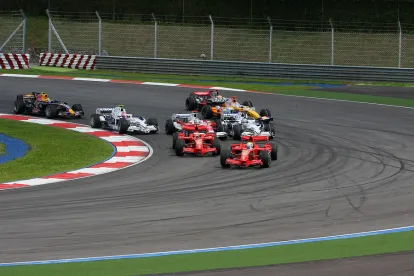Following a meeting of the Formula One Strategy Group on Wednesday, the FIA has confirmed that the ‘halo’ cockpit safety device will become mandatory in F1 cars starting from next season. The halo device is a three pronged structure with a line directly in the middle of the drivers’ sight that rises and forms a halo around the drivers head. The FIA’s statement read:
“Having developed and evaluated a large number of devices over the past five years, it had become clear that the Halo presents the best overall safety performance.”
This move comes after another safety device, the ‘cockpit shield’, a poly-carbonate see through screen that covers the driver, was tested at Silverstone last weekend. Vettel was the first driver to test the ‘shield’ but reported that it made him feel dizzy.
The need for the halo
It is perhaps unsurprising that safety is high on the agenda in a sport that sees drivers reach speeds of over 200 mph, but at various stages in the sport’s history, the need for safety has been accentuated by unfortunate events.
The death of the F1’s golden boy, Ayrton Senna, at the 1994 San Marino Grand Prix prompted a safety review that implemented changes to the head and neck support for the drivers. In 2003 the Head and Neck Support (HANS) system, a carbon fibre collar connected to the drivers’ helmet by elastic became compulsory.
Fellow Brazilian Felipe Massa suffered a brain contusion in 2009 when he was hit by a stray rear suspension spring that had fallen from Rubens Barrichello’s car during a qualifying sessions for the Hungarian F1 Grand Prix. Fortunately the incident was not fatal, but the driver was left unconscious in the cockpit with fractures to his forehead and base of the skull.
The most recent fatality in the sport occurred during the 2014 Japanese Grand Prix when Jules Bianchi crashed into a recovery vehicle at 132mph, suffering peak impact of 254G. The Maurissa driver died nine months after the crash having been in a coma since the incident.
In 2015 Maria de Villota was horrifically injured and blinded during an aerodynamics test at Duxford Aerodrome after she crashed into a loading ramp at the back of a team lorry. The female driver lost her life a year later in circumstances that were thought to be linked to the crash.
One of the main issues with safety in F1 is that the driver’s head is always exposed to some degree. Stronger, more high tech helmets go some way to adding layers of protection, but in the context of debilitating or fatal injuries, they are simply not enough.
The decision making process
It was in fact in July 2016 that the Formula One Strategy Group made the commitment to introduce additional front protection in F1 cars, a move that has been widely supported by drivers. The Strategy Group has only been in existence since 2016 and has taken on the role of vetting regulatory changes before they go to the F1 Commission for ratification.
The other important body that takes a view on matters such as this is the Grand Prix Drivers’ Association (GPDA), essentially the drivers’ union, which has been very vocal about its support for frontal protection and in particular, the halo device. The current chairman Alex Wurz criticised Bernie Ecclestone last year for putting “business first and safety second” when Ecclestone made submissions in opposition to the device.
Trade off
Finding a solution that everyone is happy with is unachievable. For some purists, the inherent danger of the sport is what makes it so thrilling, whereas for others, to accept the risk of death is just unacceptable. Aesthetically the halo changes the look of the cars, with Christian Horner the Red Bull team principal calling the device “an inelegant solution to the problem it is trying to deal with“.
However, when the FIA research shows that in every incident in the last 20 years that involved a driver’s vulnerable head, the risk would have either been reduced or unaffected, it is hard to ignore the benefits of the modification. It’s also important to remember that the halo doesn’t mark the end of the design process, as the FIA confirmed, “certain features of its design will be further enhanced”; let’s just hope that in the meantime it is someone’s saving grace.



 />i
/>i

